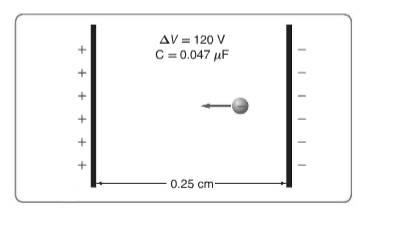
Concept explainers
(a)
The quantity of charge stored in the capacitor.
(a)
Answer to Problem 99A
Explanation of Solution
Given:
Capacitance of a capacitor is
The separation between the capacitor plates is
Potential difference between the plates is
Formula used:
The charge in the capacitor can be calculated using the equation,
Where,
Calculation:
Substituting the numerical values in equation
Conclusion:
The charge stored in the capacitor is
(b)
The strength of the electric field between the plates of the capacitor.
(b)
Answer to Problem 99A
Explanation of Solution
Given:
Capacitance of a capacitor is
The separation between the capacitor plates is
Potential difference between the plates is
Formula used:
Potential difference between the capacitor plates is,
Where,
Calculation:
Substituting the numerical values in equation
Conclusion:
The strength of the electric field between the plates of the capacitor is
(c)
Force exerted on an electron placed between the plates of a capacitor.
(c)
Answer to Problem 99A
Force exerted on an electron placed between the plates of a capacitor is
Explanation of Solution
Given:
Capacitance of a capacitor is
The separation between the capacitor plates is
Potential difference between the plates is
The position of the electron is shown in the figure below.

Formula used:
The electric field strength
Where,
Calculation:
Substituting the numerical values in equation
Conclusion:
Force exerted on an electron placed between the plates of a capacitor is
Chapter 21 Solutions
Glencoe Physics: Principles and Problems, Student Edition
Additional Science Textbook Solutions
Tutorials in Introductory Physics
Lecture- Tutorials for Introductory Astronomy
College Physics
College Physics: A Strategic Approach (3rd Edition)
University Physics Volume 1
Essential University Physics: Volume 2 (3rd Edition)
 College PhysicsPhysicsISBN:9781305952300Author:Raymond A. Serway, Chris VuillePublisher:Cengage Learning
College PhysicsPhysicsISBN:9781305952300Author:Raymond A. Serway, Chris VuillePublisher:Cengage Learning University Physics (14th Edition)PhysicsISBN:9780133969290Author:Hugh D. Young, Roger A. FreedmanPublisher:PEARSON
University Physics (14th Edition)PhysicsISBN:9780133969290Author:Hugh D. Young, Roger A. FreedmanPublisher:PEARSON Introduction To Quantum MechanicsPhysicsISBN:9781107189638Author:Griffiths, David J., Schroeter, Darrell F.Publisher:Cambridge University Press
Introduction To Quantum MechanicsPhysicsISBN:9781107189638Author:Griffiths, David J., Schroeter, Darrell F.Publisher:Cambridge University Press Physics for Scientists and EngineersPhysicsISBN:9781337553278Author:Raymond A. Serway, John W. JewettPublisher:Cengage Learning
Physics for Scientists and EngineersPhysicsISBN:9781337553278Author:Raymond A. Serway, John W. JewettPublisher:Cengage Learning Lecture- Tutorials for Introductory AstronomyPhysicsISBN:9780321820464Author:Edward E. Prather, Tim P. Slater, Jeff P. Adams, Gina BrissendenPublisher:Addison-Wesley
Lecture- Tutorials for Introductory AstronomyPhysicsISBN:9780321820464Author:Edward E. Prather, Tim P. Slater, Jeff P. Adams, Gina BrissendenPublisher:Addison-Wesley College Physics: A Strategic Approach (4th Editio...PhysicsISBN:9780134609034Author:Randall D. Knight (Professor Emeritus), Brian Jones, Stuart FieldPublisher:PEARSON
College Physics: A Strategic Approach (4th Editio...PhysicsISBN:9780134609034Author:Randall D. Knight (Professor Emeritus), Brian Jones, Stuart FieldPublisher:PEARSON





